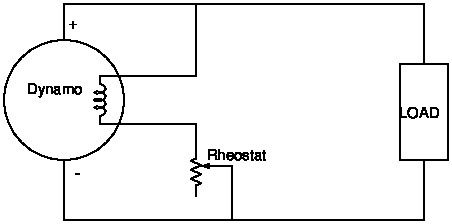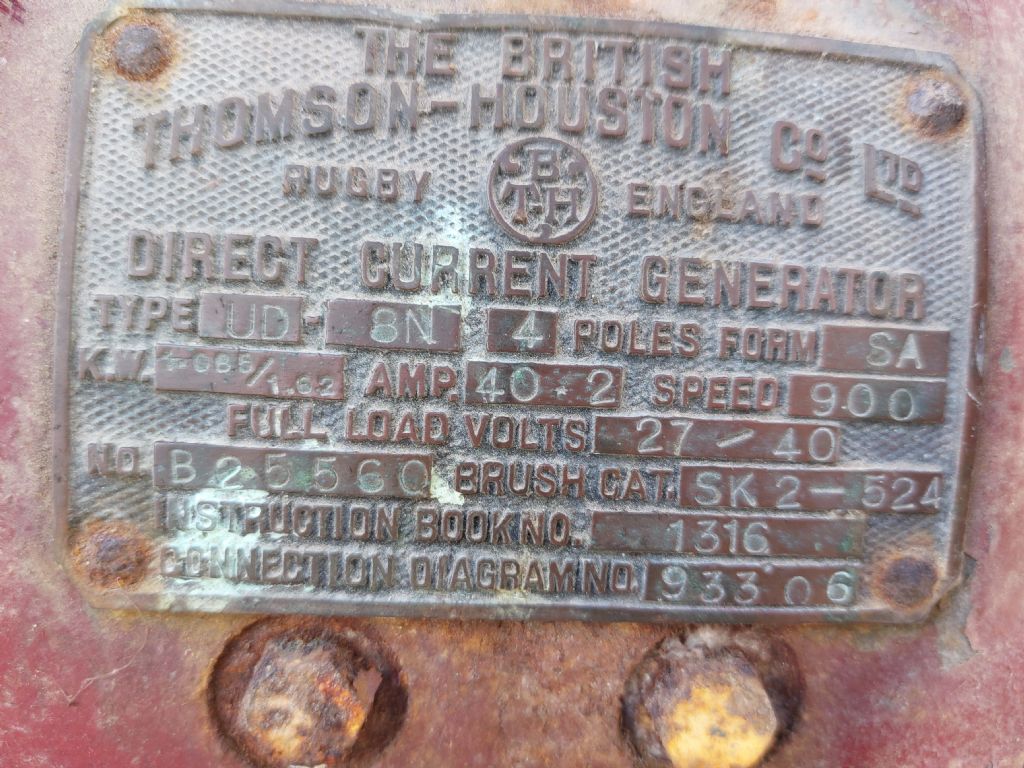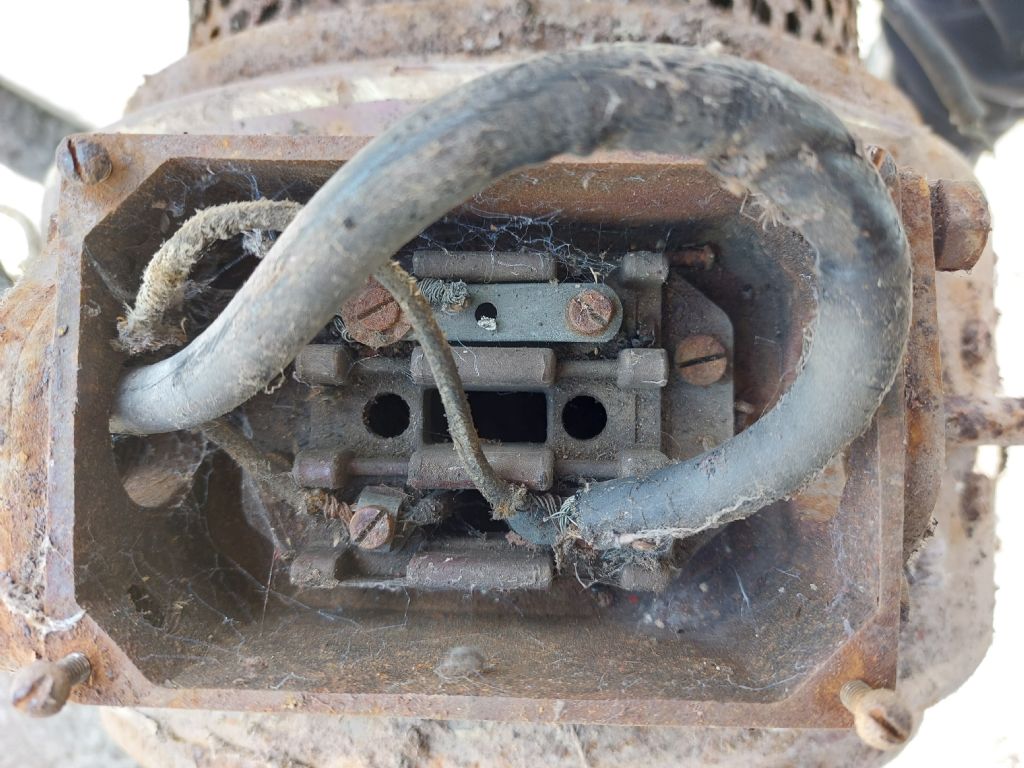BTH generator - wiring diagram
| Joe Hurley | 25/06/2022 20:36:55 |
| 4 forum posts 2 photos | Hello, I'm totally new here.... I have a British Thomson-Houston (BTH) Dynamo/DC generator ... 40 Amps at 27 to 40 Volts. I believe it may have been used to drive a fairground ? I need a wiring diagram. It has 2 light wires coming out of it, but I do not know where they "went" .... I suspect to a rheostat... for perehaps voltage control ? Can anybody point me to anywhere I could get the diagrams (I suspect it is 1930 to 1950 vintage. Thanks, Joe |
| john fletcher 1 | 26/06/2022 11:42:13 |
| 893 forum posts | Can you take a picture of the machine and its terminal box and are you certain that it is a generator and not a motor, circuit wise they are the same. Those thin wires are the shunt field pair, one of the thin pair would have been be connected to one of the main terminals and the other to some form of voltage regulator then to the other main terminal, a parallel group. I have seen at a traction engine rally where the operator used a rheostat to control the voltage to the the bulbs around the engine. John. |
| bernard towers | 26/06/2022 14:37:11 |
| 1221 forum posts 161 photos | Yes if it was a dynamo I would have expected only one output wire and usually an insulated stud in the body, the second connection being the frame. |
| SillyOldDuffer | 26/06/2022 15:51:56 |
| 10668 forum posts 2415 photos | Simplest possible circuit is like this: The wires allow amps to flow through a field winding inside the dynamo, much increasing the magnetic field and the machine's ability to generate power whilst also providing a way of controlling the output voltage to suit the load. The rheostat is a high-power resistor, usually wire-wound, and cranking the handle controls the strength of the magnetic field by adding more or less resistance to the circuit. The circuit is very old-fashioned in that it requires an operator to manage the output. Typically only used on constant loads such as a set fair-ground lights. Automatic control circuits were soon added; these cope with varying loads and don't need an operator. Various ways of doing it: motorising the rheostat, using contactors to disconnect the winding when the volts went too high and reconnect it when they went too low. Most common I think was an arrangement of contactors that provided fine control by adding or removing fixed resistors from a selection. These days it's done electronically. Stabilising circuits are more complicated. Various problems with rheostats:
Guestimating wildly - I hope someone knows better - I'd start by assuming the field current to be about 10% of the dynamo's output, so:
Suggests a rheostat of, say, 0 to 40ohms and rated for 300 or 400 watts. Probably necessary to experiment - I don't know what the field current of a BTH Dynamo should be - when new, it would have been in the manual! Dave
|
| Joe Hurley | 26/06/2022 17:20:21 |
| 4 forum posts 2 photos | Thanks v much Dave and all for informative and technical replies. I have photos of the brass plate and the wiring. I plan to post them when I figure out how ? Joe
|
| SillyOldDuffer | 26/06/2022 17:28:23 |
| 10668 forum posts 2415 photos | Welcome to the forum Joe. The forum's photo publishing is a little peculiar but easy enough when you know how! Explained here. Another quirk: the obvious search box top right of this page is pretty naff. There's a better one hiding halfway down the Home Page. Keeps us on our toes... Dave |
| John Olsen | 27/06/2022 07:02:35 |
| 1294 forum posts 108 photos 1 articles | The older style of single bar electric radiator element should be about 60 Ohms and is rated for 1kW for the whole element. About 4 Amps maximum current. So you would probably want to arrange two pieces in parallel so it does not have to run at red heat. A Carbon brush scavenged from a motor would make a good slider. That is if Dave's estimates are about right, they seem reasonable. Sometimes older generators used a vibrating contact style of regulator, these were quite usual on cars into the sixties, until alternators took over. The on/off time of the contacts reduced the current through the field to regulate the output. These were of course used with a battery which would help greatly in reducing any output voltage variations. These days it might be easier to come up with a circuit using power MOSFETs to control the field current. The circuit could easily be small enough to conceal somewhere if you want to look authentic. John |
| noel shelley | 27/06/2022 11:00:11 |
| 2308 forum posts 33 photos | Johns idea is good ! I needed a power resistor and happened to have a stock of new/old electric fire elements ! for variable resistsnce a starter motor brush would work as the slider.DO NOT try to run this machine without a load ! A 28V(24v) CAV regulator as used on the AC7 alternator might be able to be adapted to suit. Noel. |
| SillyOldDuffer | 27/06/2022 11:58:06 |
| 10668 forum posts 2415 photos | Found a book describing a 500W dynamo that quoted 2A for the field winding, so I'm a shade more confident the 4A guesstimate is in the right ball-park. Electric fire elements are a good idea, and for a test, you could just substitute an electric fire for the rheostat, wiring a domestic socket so it can be plugged straight in. Doesn't matter if L is connected to + and N to - or the other way round. Earth not needed on a 40V circuit, but as always treat electricity with due respect, shorting out 40A could start a fire, and DC arcs aren't self-extinguishing. Don't use a fan heater - the element might overheat because 40V won't run the fan needed to keep it cool. Dave |
| Joe Hurley | 28/06/2022 21:56:56 |
| 4 forum posts 2 photos | |
| Joe Hurley | 28/06/2022 21:58:10 |
| 4 forum posts 2 photos | It will be a week or two before I get back to it, but I will update. Joe |
| Howard Lewis | 29/06/2022 17:36:16 |
| 7227 forum posts 21 photos | My first car was a Singer 9. The charge rate from the 12 volt dynamo was controlled by bthe lighting switch. It had three positions "Off" fed the field coils through two resistors in series to give minimal charge rate (About enough to equate tom the ignition load. In the "Side" position one of the resistors was shorted out, increasing the charge rate. In the "Head" position, both resistors were shorted out giving the maximum charge rate (Which was pretty minimal, probably about 10 -12 Amps) to cope with the Side, Tail and "Dip and Switch" headlamps Some similar method, or variable resistor would suffice for controlling the output voltage. (My father made up a small low voltage generator set, to light a vicarage way out in the country, and the control for this was a large linear wire wound rheostat. The generator was actually a motor which had once rotated the turret on an American tank! Howard. |
Please login to post a reply.
Want the latest issue of Model Engineer or Model Engineers' Workshop? Use our magazine locator links to find your nearest stockist!
Sign up to our newsletter and get a free digital issue.
You can unsubscribe at anytime. View our privacy policy at www.mortons.co.uk/privacy
- *Oct 2023: FORUM MIGRATION TIMELINE*
05/10/2023 07:57:11 - Making ER11 collet chuck
05/10/2023 07:56:24 - What did you do today? 2023
05/10/2023 07:25:01 - Orrery
05/10/2023 06:00:41 - Wera hand-tools
05/10/2023 05:47:07 - New member
05/10/2023 04:40:11 - Problems with external pot on at1 vfd
05/10/2023 00:06:32 - Drain plug
04/10/2023 23:36:17 - digi phase converter for 10 machines.....
04/10/2023 23:13:48 - Winter Storage Of Locomotives
04/10/2023 21:02:11 - More Latest Posts...
- View All Topics
- Reeves** - Rebuilt Royal Scot by Martin Evans
by John Broughton
£300.00 - BRITANNIA 5" GAUGE James Perrier
by Jon Seabright 1
£2,500.00 - Drill Grinder - for restoration
by Nigel Graham 2
£0.00 - WARCO WM18 MILLING MACHINE
by Alex Chudley
£1,200.00 - MYFORD SUPER 7 LATHE
by Alex Chudley
£2,000.00 - More "For Sale" Ads...
- D1-3 backplate
by Michael Horley
Price Not Specified - fixed steady for a Colchester bantam mark1 800
by George Jervis
Price Not Specified - lbsc pansy
by JACK SIDEBOTHAM
Price Not Specified - Pratt Burnerd multifit chuck key.
by Tim Riome
Price Not Specified - BANDSAW BLADE WELDER
by HUGH
Price Not Specified - More "Wanted" Ads...
Do you want to contact the Model Engineer and Model Engineers' Workshop team?
You can contact us by phone, mail or email about the magazines including becoming a contributor, submitting reader's letters or making queries about articles. You can also get in touch about this website, advertising or other general issues.
Click THIS LINK for full contact details.
For subscription issues please see THIS LINK.
Model Engineer Magazine
- Percival Marshall
- M.E. History
- LittleLEC
- M.E. Clock
ME Workshop
- An Adcock
- & Shipley
- Horizontal
- Mill
Subscribe Now
- Great savings
- Delivered to your door
Pre-order your copy!
- Delivered to your doorstep!
- Free UK delivery!













 Register
Register Log-in
Log-in


